
Connellsville


 According to the World Health Organization (WHO), over 2.8 million people die each year due to complications resulting from obesity. Researchers at the University Hospital in Denmark conducted a study that showed obesity was linked to an increased risk of rheumatoid arthritis development in women. This is largely attributed to the fact that obesity disrupts bone health and development. Rheumatoid arthritis is a condition that affects the joints in the feet, hands, and knees. While there isn’t a cure for the inflammatory disorder, the best way to treat it is by use of medication and physical therapy.
According to the World Health Organization (WHO), over 2.8 million people die each year due to complications resulting from obesity. Researchers at the University Hospital in Denmark conducted a study that showed obesity was linked to an increased risk of rheumatoid arthritis development in women. This is largely attributed to the fact that obesity disrupts bone health and development. Rheumatoid arthritis is a condition that affects the joints in the feet, hands, and knees. While there isn’t a cure for the inflammatory disorder, the best way to treat it is by use of medication and physical therapy.
Obesity has become very problematic at this point in time and can have extremely negative effects on the feet. If you’re an obese individual and are concerned about your feet, contact Dr. Arnold Tarpley, Jr. from Tarpley Foot and Ankle Center. Dr. Tarpley can provide the care you need to keep you pain-free and on your feet.
Obesity and Your Feet
Since your feet are what support your entire weight when standing, any additional weight can result in pain and swelling. Being overweight is one of the main contributors to foot complications.
Problems & Complications
Extra Weight – Even putting on just a few extra pounds could create serious complications for your feet. As your weight increases, your balance and body will shift, creating new stresses on your feet. This uneven weight distribution can cause pain, even while doing the simplest tasks, such as walking.
Diabetes – People who are overweight are at serious risk of developing type-2 diabetes, which has a drastic impact on the health of your feet. As you get older, your diabetes might worsen, which could lead to loss of feeling in your feet, sores, and bruises. You could also become more prone to various infections.
Plantar fasciitis – Pressure and stress that is placed on muscles, joints, and tendons can trigger plantar fasciitis, which is an inflammation of tissue that forms along the bottom of the foot.
If you have any questions please feel free to contact one of our offices located in Uniontown, and Connellsville, PA . We offer the newest diagnostic and treatment technologies for all your foot and ankle needs.
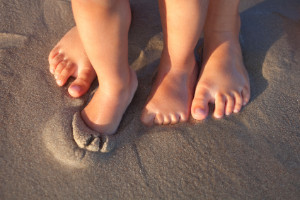 Surprisingly, there are girls who are as young as six-years-old who are starting to wear heels. Researchers have found that celebrities such as Taylor Swift and girl-group ‘Little Mix’ are part of the reason why young girls are wanting to wear heels. According to a study, one in ten girls begins to wear small heeled shoes at age six, which may cause the calf muscles to shorten while also putting pressure on the ball of the foot. Another study was able to find that children are in danger of suffering long term damage to their feet due to the unsuitable shoes they are wearing. It is crucial that parents have their child’s feet measured from ages one to three, because this is the stage where foot growth occurs most rapidly.
Surprisingly, there are girls who are as young as six-years-old who are starting to wear heels. Researchers have found that celebrities such as Taylor Swift and girl-group ‘Little Mix’ are part of the reason why young girls are wanting to wear heels. According to a study, one in ten girls begins to wear small heeled shoes at age six, which may cause the calf muscles to shorten while also putting pressure on the ball of the foot. Another study was able to find that children are in danger of suffering long term damage to their feet due to the unsuitable shoes they are wearing. It is crucial that parents have their child’s feet measured from ages one to three, because this is the stage where foot growth occurs most rapidly.
Making sure that your children maintain good foot health is very important as they grow. If you have any questions, contact Dr. Arnold Tarpley, Jr. of Tarpley Foot and Ankle Center. Dr. Tarpley can provide the care you need to keep you pain-free and on your feet.
Keeping Children's Feet Healthy
Having healthy feet during childhood can help prevent medical problems later in life, namely in the back and legs. As children grow, their feet require different types of care. Here are some things to consider...
Although babies do not walk yet, it is still very important to take care of their feet.
Avoid putting tight shoes or socks on his or her feet.
Allow the baby to stretch and kick his or her feet to feel comfortable.
As a toddler, kids are now on the move and begin to develop differently. At this age, toddlers are getting a feel for walking, so don’t be alarmed if your toddler is unsteady or ‘walks funny’.
As your child gets older, it is important to teach them how to take care of their feet.
Show them proper hygiene to prevent infections such as fungus.
Be watchful for any pain or injury.
Have all injuries checked by a doctor as soon as possible.
Comfortable, protective shoes should always be worn, especially at play.
If you have any questions please feel free to contact one of our offices located in Uniontown, and Connellsville, PA . We offer the newest diagnostic and treatment technologies for all your foot and ankle needs.
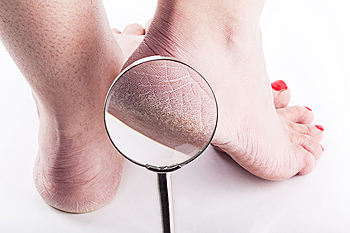 Cracked heels can affect anyone of any age, and they are caused by a lack of moisture. Thankfully, at-home remedies may be performed in order to rid yourself of this unsightly condition. Prior to treating your cracked heels, it is crucial that you are aware of what may be causing them. Cold weather, harsh soaps, standing for long hours, and improper footwear have all been linked as causes of cracked heels. A simple treatment you can try for cracked feet is to soak them in warm soapy water for twenty minutes at night. Afterwards, try using a pumice stone to scrape off any dead skin you may have. You should then rinse your feet, and carefully dry them with a towel. Lastly, moisturize them with a foot cream and wear a pair of socks overnight in order to trap in the moisture. If you have a more severe case of cracked heels, you should not hesitate to seek help from a podiatrist.
Cracked heels can affect anyone of any age, and they are caused by a lack of moisture. Thankfully, at-home remedies may be performed in order to rid yourself of this unsightly condition. Prior to treating your cracked heels, it is crucial that you are aware of what may be causing them. Cold weather, harsh soaps, standing for long hours, and improper footwear have all been linked as causes of cracked heels. A simple treatment you can try for cracked feet is to soak them in warm soapy water for twenty minutes at night. Afterwards, try using a pumice stone to scrape off any dead skin you may have. You should then rinse your feet, and carefully dry them with a towel. Lastly, moisturize them with a foot cream and wear a pair of socks overnight in order to trap in the moisture. If you have a more severe case of cracked heels, you should not hesitate to seek help from a podiatrist.
Cracked heels are unsightly and can cause further damage to your shoes and feet. If you have any concerns, contact Dr. Arnold Tarpley, Jr. from Tarpley Foot and Ankle Center. Dr. Tarpley can provide the care you need to keep you pain-free and on your feet.
Cracked Heels
Cracked heels appear unappealing and can make it harder for you walk around in sandals. Aside from looking unpleasant, cracked heels can also tear stockings, socks, and wear out your shoes. There are several methods to help restore a cracked heel and prevent further damage.
How Do You Get Them?
Dry skin is the number one culprit in creating cracked heels. Many athletes, walkers, joggers, and even swimmers suffer from cracked heels. Age and skin oil production play a role to getting cracked heels as well.
Promote Healing
Over the counter medicines can help, especially for those that need instant relief or who suffer from chronic dry feet.
Wear Socks – Wearing socks with medicated creams helps lock in moisture.
Moisturizers – Applying both day and night will help alleviate dryness which causes cracking.
Pumice Stones – These exfoliate and remove dead skin, which allows for smoother moisturizer application and better absorption into the skin.
Change in Diet
Eating healthy with a well-balanced diet will give the skin a fresh and radiant look. Your body responds to the kinds of food you ingest. Omega-3 fatty acids and zinc supplements can also revitalize skin tissue.
Most importantly, seek professional help if unsure how to proceed in treating cracked heels. A podiatrist will help you with any questions or information needed.
If you have any questions, please feel free to contact one of our offices located in Uniontown, and Connellsville, PA . We offer the newest diagnostic and treatment technologies for all your foot care needs.
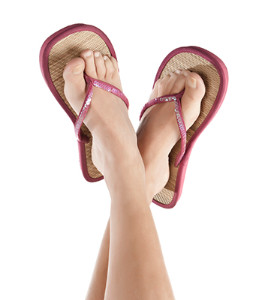 Plantar fasciitis is a common condition that tends to appear during the summer months, and flip-flops could be one of the reasons this happens. Flip-flops offer no support for the feet, which causes the plantar fascia to stretch unnaturally; this may lead to heel pain. Wearing flip-flops also causes you to scrunch your toes in order to grip the thong of the sandal, causing you to shorten your stride. As a result, you may experience hammertoes, muscle pain, and shin splits from forcing your legs to work harder.
Plantar fasciitis is a common condition that tends to appear during the summer months, and flip-flops could be one of the reasons this happens. Flip-flops offer no support for the feet, which causes the plantar fascia to stretch unnaturally; this may lead to heel pain. Wearing flip-flops also causes you to scrunch your toes in order to grip the thong of the sandal, causing you to shorten your stride. As a result, you may experience hammertoes, muscle pain, and shin splits from forcing your legs to work harder.
Flip-flops are not always the best choice of footwear. If you have any concerns about your feet or ankles, contact Dr. Arnold Tarpley, Jr. from Tarpley Foot and Ankle Center. Dr. Tarpley will assist you with all of your foot and ankle needs.
Flip-Flops and Feet
When the weather starts warming up, people enjoy wearing flip-flops. Flip-flops are comfortable, stylish, and easy to slip on and off; they're perfect for any summer beach goer. However, these shoes can cause harm to the feet.
How Can Flip-Flops Affect Me Long-Term?
Are There Injuries Associated with Flip-Flops?
Yes. Since flip-flops are relatively weak and do not provide the same amount of support as sneakers, people who wear flip-flops regularly are more susceptible to injuries. On top of that, the open nature of the shoe makes your feet more prone to other problems, such as cuts and even infections. Common injuries and ailments include:
I like Wearing Flip-Flops. Are There Safe Alternatives?
When buying flip-flops, try to find ones that have sturdy soles and that are made of high-quality materials that will support for your feet. These flip-flops will cost more but will also last longer as a result.
If you have any questions please feel free to contact one of our offices located in Uniontown, and Connellsville, PA . We offer the newest diagnostic and treatment technologies for all your foot and ankle needs.
 Hammertoe is caused when there is a muscle and ligament imbalance around the toe joint. This causes the middle joint of the toe to bend and become stuck in this position . Many people with hammertoe complain about rubbing and irritation at the top of the bent toe. Toes that tend to unnaturally curl, such as the baby toe, are also considered hammertoes. “Flexible” and “Rigid” are the two main types of hammertoes. If the toe can still be moved around, it is considered a flexible hammertoe. Hammertoes that don’t allow for any toe movement are classified as rigid hammertoes.
Hammertoe is caused when there is a muscle and ligament imbalance around the toe joint. This causes the middle joint of the toe to bend and become stuck in this position . Many people with hammertoe complain about rubbing and irritation at the top of the bent toe. Toes that tend to unnaturally curl, such as the baby toe, are also considered hammertoes. “Flexible” and “Rigid” are the two main types of hammertoes. If the toe can still be moved around, it is considered a flexible hammertoe. Hammertoes that don’t allow for any toe movement are classified as rigid hammertoes.
Hammertoe
Hammertoes can be a painful condition to live with. For more information, contact Dr. Arnold Tarpley, Jr. from Tarpley Foot and Ankle Center. Dr. Tarpley will answer any of your foot- and ankle-related questions.
Hammertoe is a foot deformity that affects the joints of the second, third, fourth, or fifth toes of your feet. It is a painful foot condition in which these toes curl and arch up, which can often lead to pain when wearing footwear.
Symptoms
Causes
Genetics – People who are genetically predisposed to hammertoe are often more susceptible
Arthritis – Because arthritis affects the joints in your toes, further deformities stemming from arthritis can occur
Trauma – Direct trauma to the toes could potentially lead to hammertoe
Ill-fitting shoes – Undue pressure on the front of the toes from ill-fitting shoes can potentially lead to the development of hammertoe
Treatment
Orthotics – Custom made inserts can be used to help relieve pressure placed on the toes and therefore relieve some of the pain associated with it
Medications – Oral medications such as anti-inflammatories or NSAIDs could be used to treat the pain and inflammation hammertoes causes. Injections of corticosteroids are also sometimes used
Surgery – In more severe cases where the hammertoes have become more rigid, foot surgery is a potential option
If you have any questions please contact one of our offices located in Uniontown, and Connellsville, PA . We offer the newest diagnostic and treatment technologies for all your foot and ankle needs.
Hyperhidrosis is identified as a medical condition which leads to overactive sweat glands, also associated with higher rates of anxiety and even depression in those who are affected. According to a study by the American Academy of Dermatology (AAD), “21 percent of people with hyperhidrosis had anxiety, and 27 percent of people with this ailment had depression.” Hyperhidrosis can occur regardless of factors such as temperature, and can occur in any region of our body. However, in most cases it typically affects the feet, hands, and underarms. Nearly 3 percent of the population is afflicted by this condition.
If you are suffering from hyperhidrosis contact Dr. Arnold Tarpley, Jr. of Tarpley Foot and Ankle Center. Dr. Tarpley can provide the care you need to attend to all of your foot and ankle needs.
Hyperhidrosis of the Feet
Hyperhidrosis is a rare disorder that can cause people to have excessive sweating of their feet. This can usually occur all on its own without rigorous activity involved. People who suffer from hyperhidrosis may also experience sweaty palms.
Although it is said that sweating is a healthy process meant to cool down the body temperature and to maintain a proper internal temperature, hyperhidrosis may prove to be a huge hindrance on a person’s everyday life.
Plantar hyperhidrosis is considered to be the main form of hyperhidrosis. Secondary hyperhidrosis can refer to sweating that occurs in areas other than the feet or hands and armpits. Often this may be a sign of it being related to another medical condition such as menopause, hyperthyroidism and even Parkinson’s disease.
In order to alleviate this condition, it is important to see your doctor so that they may prescribe the necessary medications so that you can begin to live a normal life again. If this is left untreated, it is said that it will persist throughout an individual’s life.
A last resort approach would be surgery, but it is best to speak with your doctor to find out what may be the best treatment for you.
If you have any questions please feel free to contact one of our offices located in Uniontown, and Connellsville, PA . We offer the newest diagnostic and treatment technologies for all your foot and ankle needs.
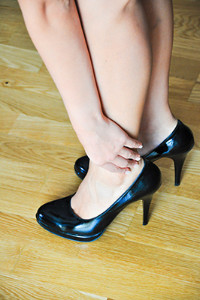 High heels are a constant source of foot problems for women of all ages. Though many feel they need to make sacrifices to look fashionable, the high heel can do real damage. Wearing of heels over time can cause pain in joints and tendons, and can even mishape your foot. Bunions and calluses can form as well. Women overwhelming suffer more from bunions than men due to wearing of high heels. Interestingly, the only global populations where the incidence of bunions is relatively equal between the sexes is in countries where people are mainly barefoot. For people who work on their feet a lot, it would be best to consider limiting the time spent in high heels.
High heels are a constant source of foot problems for women of all ages. Though many feel they need to make sacrifices to look fashionable, the high heel can do real damage. Wearing of heels over time can cause pain in joints and tendons, and can even mishape your foot. Bunions and calluses can form as well. Women overwhelming suffer more from bunions than men due to wearing of high heels. Interestingly, the only global populations where the incidence of bunions is relatively equal between the sexes is in countries where people are mainly barefoot. For people who work on their feet a lot, it would be best to consider limiting the time spent in high heels.
High heels have a history of causing foot and ankle problems. If you have any concerns about your feet or ankles, contact Dr. Arnold Tarpley, Jr. from Tarpley Foot and Ankle Center. Dr. Tarpley can provide the care you need to keep you pain-free and on your feet.
Effects of High Heels on the Feet
High heels are popular shoes among women because of their many styles and societal appeal. Despite this, high heels can still cause many health problems if worn too frequently.
Which Parts of My Body Will Be Affected by High Heels?
What Kinds of Foot Problems Can Develop from Wearing High Heels?
How Can I Still Wear High Heels and Maintain Foot Health?
If you want to wear high heeled shoes, make sure that you are not wearing them every day, as this will help prevent long term physical problems. Try wearing thicker heels as opposed to stilettos to distribute weight more evenly across the feet. Always make sure you are wearing the proper shoes for the right occasion, such as sneakers for exercising. If you walk to work, try carrying your heels with you and changing into them once you arrive at work. Adding inserts to your heels can help cushion your feet and absorb shock. Full foot inserts or metatarsal pads are available.
If you have any questions please feel free to contact one of our offices located in Uniontown, and Connellsville, PA . We offer the newest diagnostic and treatment technologies for all your foot and ankle needs.
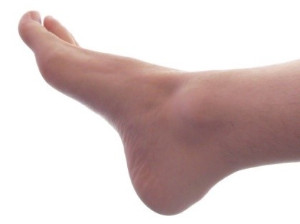 There are over 100 different varieties of HPV, or human papilloma virus. Nearly 12% of the global population have had warts at one time, and plantar warts are but one of these types. They all share one basic characteristic, they have the ability to infect skin cells. Many people, when they hear the term HPV, think that it refers to genital warts. But this is not the case, and HPV can manifest itself in many different forms. Plantar warts occur on the feet, typically on the palms or the soles. They can be flat or raised, and usually occur in dry, cracked areas of the foot. Treatments vary in scope and effectiveness. If you think you may have a plantar wart, talk to your podiatrist and go through the treatment options available.
There are over 100 different varieties of HPV, or human papilloma virus. Nearly 12% of the global population have had warts at one time, and plantar warts are but one of these types. They all share one basic characteristic, they have the ability to infect skin cells. Many people, when they hear the term HPV, think that it refers to genital warts. But this is not the case, and HPV can manifest itself in many different forms. Plantar warts occur on the feet, typically on the palms or the soles. They can be flat or raised, and usually occur in dry, cracked areas of the foot. Treatments vary in scope and effectiveness. If you think you may have a plantar wart, talk to your podiatrist and go through the treatment options available.
Plantar warts can be very uncomfortable. If you need your feet checked, contact Dr. Arnold Tarpley, Jr. from Tarpley Foot and Ankle Center. Dr. Tarpley will assist you with all of your foot and ankle needs.
About Plantar Warts
Plantar warts are the result of HPV, or human papillomavirus, getting into open wounds on the feet. They are mostly found on the heels or balls of the feet.
While plantar warts are generally harmless, those experiencing excessive pain or those suffering from diabetes or a compromised immune system require immediate medical care. Plantar warts are easily diagnosed, usually through scraping off a bit of rough skin or by getting a biopsy.
Symptoms
Treatment
To help prevent developing plantar warts, avoid walking barefoot over abrasive surfaces that can cause cuts or wounds for HPV to get into. Avoiding direct contact with other warts, as well as not picking or rubbing existing warts, can help prevent the further spread of plantar warts. However, if you think you have developed plantar warts, speak to your podiatrist. He or she can diagnose the warts on your feet and recommend the appropriate treatment options.
If you have any questions please feel free to contact one of our offices located in Uniontown, and Connellsville, PA . We offer the newest diagnostic and treatment technologies for all your foot and ankle needs.